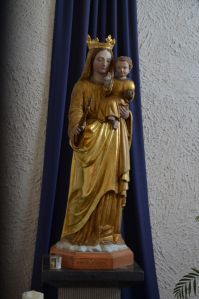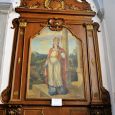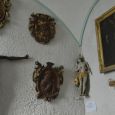Church | 1763 | Baroque | Catholic Church



Map
Opening hours
01 January - 31 December
Mon 9.00 - 18.00
Tue 9.00 - 18.00
Wed 9.00 - 18.00
Thu 9.00 - 18.00
Fri 9.00 - 18.00
Sat 9.00 - 18.00
Sun 9.00 - 18.00
Religious offices
Description
Originally, these two churches were founded by two neighbouring abbeys – the church of St. Vaast at Hergie by the abbey of Hautmont, and that of St. Martin by the Abbey of Lobbes (in Belgium nearby).
The church of St. Martin is near to the site of a very old castle which sheltered, in the 9th century the frustrated love affair of the king of Lotharginie, great grandson of Charlemagne. The sovereign fought all his life to repudiate the wife who had been forced on him, and to marry Waldrade. This history of faithful love caused a long political and religious conflict between the king, the emperor and the pope, and even convened two synods. The two lovers met at Hon where Waldrade lived in retirement. They had four children, of whom two were buried in the church. One of the children, Hugues, became Abbot of St. Peter, Abbey of Lobbes, to which the village of Hon was attached by his father at the request of his mother.
The stone church , too small and in disrepair, was rebuilt in the 18th century (between 1764 and 1769) in the baroque style . All of the old church was recuperated, the stone masonry of the foundations in sandstone, up to the base of the windows. Larger, in brick and stone the new church can be recognised by its bulb-shaped steeple in the bavasien style . The inside of the luminous church with its side aisles, is roofed with high arched vaults from the 16th century. At the back of the church several statues from the previous church can be admired, and also the very beautiful organ case. The sanctuary, also very light, is immense for a village church, like all the monastic foundations of the time.
At the beginning of the 20th century a new bell replaced those which had been melted down during the Revolution, and which came from the old wooden belfry – and new windows were installed. Today the church is still the centre of an important pilgrimage dedicated to the cult of Our Lady of Hon.
Photos
Remarkable elements
Toiles marouflées du XVIIIe
L’église présente quatre tableaux remarquables, inscrits Monuments Historiques : deux représentations de saint Martin, une Assomption et une Annonciation. Le retable de l’Annonciation est une copie d’une œuvre de Rubens, visible au musée de Valenciennes, par un peintre valenciennois.
Notre-Dame de Hon
Dans la chapelle qui lui est dédiée, la Vierge à l’Enfant couronnée, dorée à la feuille, date du XIXe siècle. Elle est toujours aujourd’hui l’objet d’un important pèlerinage en septembre, témoignage d’une forte dévotion mariale depuis le miracle de 1215, quand les paroissiens de Bavay entamèrent un pèlerinage en l’honneur de Marie pour demander la
guérison de la peste qui « précipitait les populations au tombeau ». Devant la chapelle de Hon, située au bout de l’actuel chaussée du bois et détruite en 1709 suite à la bataille de Malplaquet, « Notre-Dame a balayé de ses bras puissant l’air pestilentiel (...) les démons, de rage, éteignirent les cierges des clients de Marie ». Plusieurs chapelles furent alors élevées en l’honneur de Notre- Dame de Hon, sous l’impulsion des marchands lombards, comme à Mons par exemple. La statue de Notre-Dame de Hon est une copie, plus petite, provenant de la chapelle de Mons détruite à la Révolution Française.
Clocher à Bulbe
De type bavaisien, il est édifié en 1769. Il reprend les caractéristiques baroques et les influences du Saint- Empire-Romain-Germanique. Cette influence s’explique par l’autorité exercée par l’abbaye de Lobbes, située dans le diocèse de Liège.
Maître-Autel du XVIIIe et Gloire
Derrière l’expositoire du maître- autel en bois sculpté (inscrit Monument Historique), le fond du chœur est orné d’une impressionnante gloire rayonnante portant l’inscription « Gloria in excelsis Deo ». Il s’agit d’un chant de louange à la Sainte
Trinité, dont le Saint-Esprit est présent sur l’expositoire, extrait du chant des anges à Bethléem tiré de l’Evangile de Luc. La plupart des grands compositeurs ont repris ce texte pour en tirer des œuvres musicales célèbres (Charpentier, Vivaldi, Bach, Haendel …).
Quatre blochets
Sous la tribune se trouvent quatre blochets sculptés. Il s’agit de pièces en bois servant d’appui à la charpente, courants dans le Hainaut et l’Oise depuis le XVe siècle. Les quatre blochets représentent des apôtres, de gauche à droite : saint Thadée avec sa masse, saint Simon avec sa scie, saint Jacques avec son bourdon et sa besace et saint Pierre.
Le trésor sculpté de Hon
La chapelle présente un certain nombre de biens, inscrits Monuments Historiques. Huit médaillons en bois (XVIIIe), provenant de l’abbaye de Lobbes, côtoient les statues de sainte Anne avec la Vierge Marie enfant (XVIe), de saint Roch et son chien (XVIIIe), de saint Martin à cheval (XIXe), de saint Sébastien, patron des archers (XVIIIe), de saint Éloi avec son marteau (XVIIe), saint Jean (XVIIIe), une Vierge à l’Enfant et deux Christ en croix dont l’un provient du calvaire (XVIIe).





























